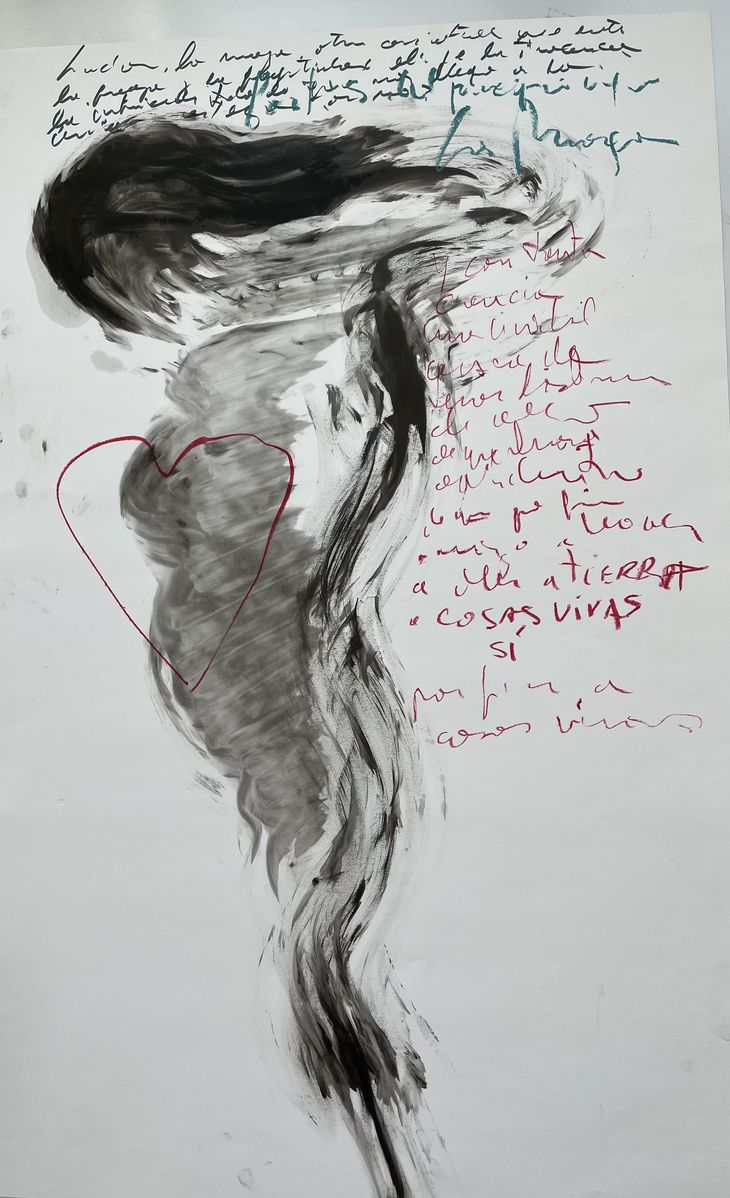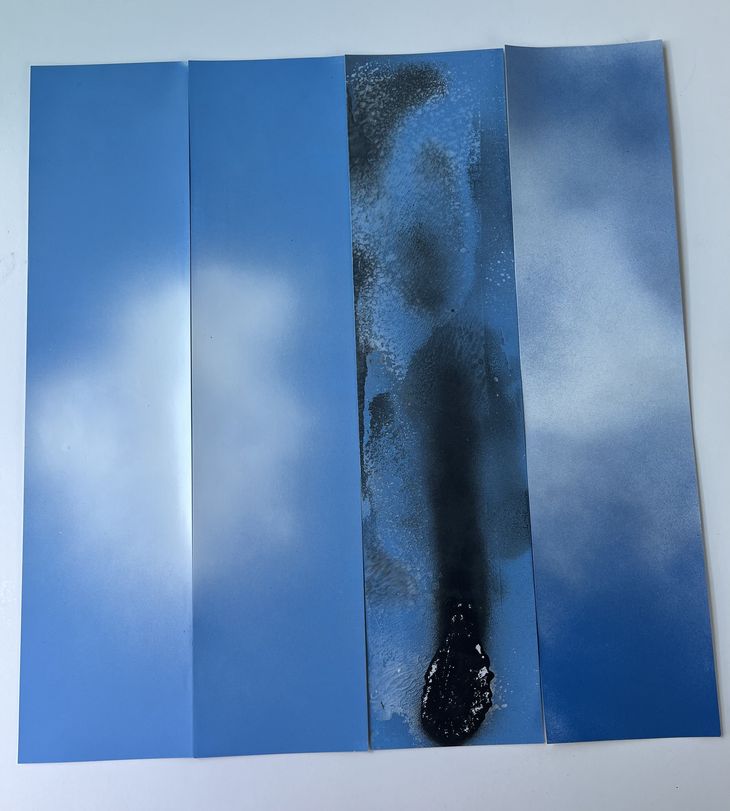“I always carry with me a phrase from Herman Hesse, which I used in a work that I just exhibited in Turin, and which says ‘Water is stronger than rock, and love is stronger than violence.’.” Who is telling this is Liliana Livnehinternational Argentine artist, resident for years in Tel Aviv, who two exhibitions of his new works, almost consecutive, brought him back to Buenos Aires for a time.
In a text about the artist, the critic Julio SapollNik expresses that in the paintings of Livneh “something is about to be discovered, something is about to be revealed. Art is not what you see, it is the freedom to intuit what it proposes. It is about the ‘zero signifier’: that which has already occurred or is about to occur.”. This look, so precise, that in some way gives a broader temporal meaning to the “Art happens” by Whistler) gave rise to our conversation with her.
“My connection is to dialogue with those who contemplate the work,” says Livneh. “I work, but if another person imagines something different that is also valid. I don’t usually do self-portraits, but I did one once, and almost everyone told me ‘How beautiful that moose is.’ This was a long time ago, but it could also happen today. It means that there is a dialogue that promotes the imagination of the other, and also allows me to imagine.”
Livneh refuses to define her painting, because every definition (if we stick to the etymology of the word) means setting limits on something. And art does not have them. ““I don’t do abstract art.”keep going, “but I use the figure to say something abstract: an idea, a concept, something cognitive. My figures are like ethereal, or sinuous; “They invite the other to think something that may not be what I think.” He also denies that this use, or deformation of the figure, can be “Picassian.”
“I I feed on poetry and literature. It is no coincidence that he has held an exhibition and installation on Alejandra Pizarnik at the Hebrew University, and at the Cervantes Institute in Tel Aviv an exhibition and installation on Julio Cortázar” (which has nothing to do with the current one, which will be talked about later).
“And here in Buenos Aires,” he remembers, “at the Borges Cultural Center, I had a very large exhibition, it covered an entire floor, which was called ‘Poetry and the body‘. I searched for the bodies of women-caryatids that I paint were the guardians of the poetry that I read: there was an open endless number of poets that I like, from the very Borges to Emily Dickinson or Pessoa”.
“That’s why,” he continues.Many times I paint and write: the letters, typographically, become drawings or lines: I don’t write something to be read, but I do it to be felt. The line may be a figure, or the reminiscence of a figure, or a hint of form perhaps followed by a word. That mixes. For me, writing or reading and painting is like a single language.”
Primera.jpg
“Lights and shadows”
Liliana Livneh’s first exhibition, “Lights and shadows”will open tomorrow, and will remain open until June 7 in GalleryLabs, Graciela Sapia’s space at Esmeralda 986, mezzanine. “It is a gallery that opened just a year ago,” says the artist, “but it was already working, although without physical space with trade fairs abroad: I worked a lot with them in New York, in Miami, at Art Basel.”
“Here I present what I could call fragments of what I lived and felt throughout different days.” observes “and then I put it together as if it were a puzzle. Each work received its fragment, joined later. That is to say, once I had gathered all the fragments of what I painted, things that I felt on a daily basis, they came together according to an aesthetic and organic criterion.”
Regarding the materials with which he worked, he points out: “There are also works there that are wooden triangles on which I also paint, or practice collages. Almost all the work is made of wood, and also the wooden triangles, which are made with paper. “I started with them when I did the exhibition about Alejandra Pizarnik, who is one of the many writers who influenced my life”
“But without a doubt,” he continues, Borges’s literature also left a deep mark on me. The exhibition is called ‘Lights and Shadows’, because there is something very bright and also pain; uprooting Life is made of those contrasts, of that yin yang that forms a whole. And I work a lot with contrasts, with very bright colors and a lot of black and white.”
Second.jpg

Cortazar
“Reading Cortazar”the second of the samples, will take place in the Arcimboldo Gallery, from Pelusa Borthwick (Reconquista 761 PB 14) between June 5 and 12. That is, it will open almost at the close of the previous one (there is an overlap of two days), and will last only for one week.
“In this exhibition“, clarifies the artist”Most of the works are in black and white, as if they were writing. And I want to clarify that they are completely new worksbecause the one I already presented about him is another. Everything I brought now, for both exhibitions is from 2024. In GalleryLabs there are about 24 works, and here about twelve. “The exhibition revolves exclusively around ‘Rayuela’ and not about the world of Cortázar in general.”
“I was thinking about that novel“, refers to the Cortazarian classic whose 60 years of appearance were completed last year “and I painted phrases that came to my head, not necessarily literal: there is a mixture of writing with shapes and images that form a whole. It’s what ‘Hopscotch’ left in me, things that Oliveira said, or could have said according to my memory, to another of the characters. It’s quite literal, but I didn’t copy those phrases from the book. There is nothing better than rereading a book, and especially a novel like ‘Hopscotch’. These works are my way of rereading.”
About his life, Livneh He says: “I am from Buenos Aires, but I have a triangle called ‘La Feliz’, since I always associate my childhood in Mar del Plata, where we went with my family every summer and we stayed there for the three summer months. I married an Israeli, we went around the world, we visited all of South America, the United States and Europe, and finally we settled in Tel Aviv, where I have my atelier. However, I go out, I travel, I exhibit in other places, and I have the feeling that where I am, there is my home. When I return to Buenos Aires I feel like I never left.”.
In her farewell, she highlights what is most important to her: peace and understanding. “I did and do a lot of work that talks about beauty. of diversity, of inclusion, of women: in my caryatids, I have reminiscences of Greek culture, of being a daughter of that culture, which is why so many of my works have names from Greek mythology, such as ‘I dream on Naxos’.”
“Thus,” concludes the artist, whose works and career can be consulted at linktr.ee/LilianaLivneh, “I made many projects about peace: I worked with the Peres Center for Peace, founded by Shimon Peres. I created the logo for the Seminar of that Center, which is in Mexico, at the University of Anáhuac, and also another for the Pignatelli Center for Peace, in Zaragoza. I am sure that human beings have much more in common with each other than the other way around.”.
Source: Ambito
I am an author and journalist who has worked in the entertainment industry for over a decade. I currently work as a news editor at a major news website, and my focus is on covering the latest trends in entertainment. I also write occasional pieces for other outlets, and have authored two books about the entertainment industry.




